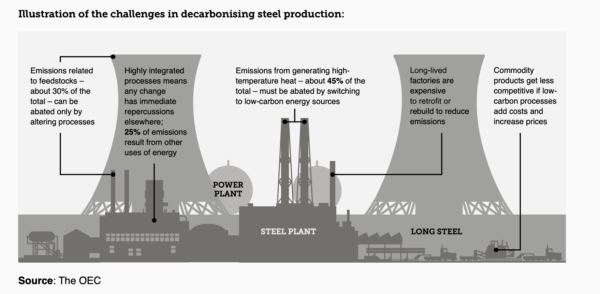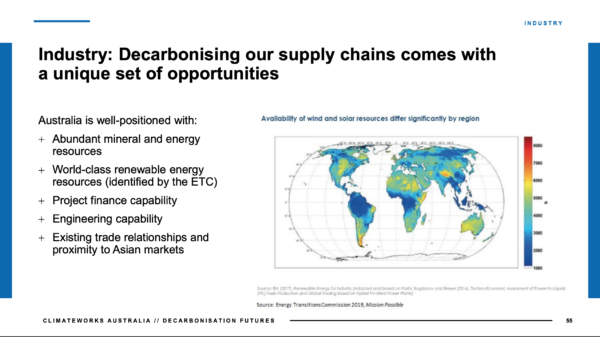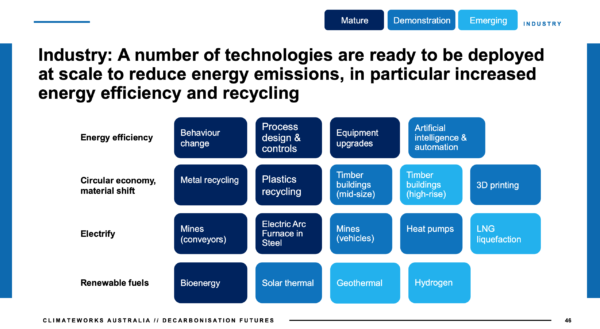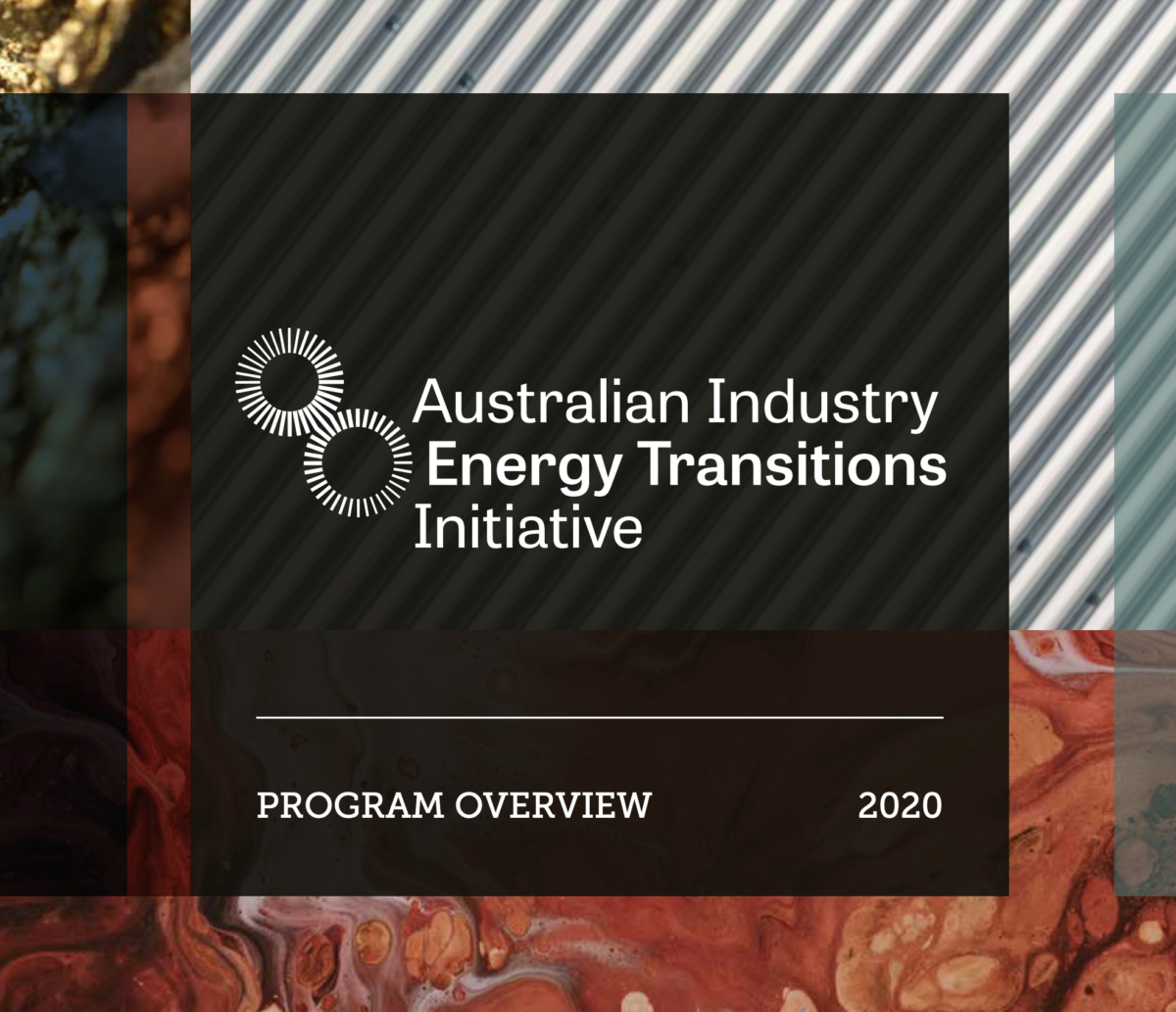A new initiative convened by not-for-profit organisations ClimateWorks Australia and Climate-KIC Australia, supported by a $300,000 grant from the Australian Renewable Energy Agency, is gathering the collective nous and resources of Australia’s biggest industrial players to effectively share knowledge, and apply renewable-energy technologies to slash emissions from hard-to-abate sectors that make up more than a quarter of Australia’s greenhouse gas output.
The Australian Industry Energy Transitions Initiative (ETI) is focused on five key industry areas:
- Iron and steel
- Aluminium
- Liquefied natural gas (LNG)
- Other metals (copper, nickel, lithium…)
- Chemicals, particularly fertilisers and explosives

Image: Observatory of Economic Complexity (OEC)
“Corporates generate frequent criticism,” says Simon McKeon, Chair of the initiative in his forward to the Program Overview, “But I also know that they have extraordinary resources, fabulous people and have the ability to effect enormous change.”
McKeon, who is Chancellor of Monash University and a non-executive director of National Australia Bank and Rio Tinto Group among many other mover-and-shaker appointments, writes also that there is reason to be “appropriately and sensibly optimistic” about the prospects for carbon abatement by industry, “recognising the solutions at our disposal and in particular the new technologies that are emerging”.
A vanguard of industrial change makers
The bold and foresightful group of industrials participating in the ETI includes BHP, Woodside, BlueScope Steel, BP Australia, Orica, APA Group, Australian Gas Infrastructure Group (AGIG) and Wesfarmers Chemicals, Energy and Fertilisers. Joining them are National Australia Bank, Schneider Electric and Australian Super, representatives of the investment and services sectors that will support industry action in achieving net-zero.
ETI’s program is directed towards practicalities, with research partners CSIRO and the Rocky Mountain Institute, along with co-convenors ClimateWorks and Climate-KIC, having conducted preliminary research, and which will now collaboratively fill research gaps, identify challenges and develop projects for implementation.
In April, ClimateWorks, for example, laid substantial groundwork in its Decarbonisation Futures: Solutions, actions and benchmarks for a net zero emissions Australia report.

Image: ClimateWorks Australia
The ETI will focus not only on reducing emissions generated on home soil, but the participating companies have committed to accelerate action towards achieving net-zero emissions in their supply chains by 2050.
“Emissions aren’t contained within national borders and aren’t confined to what happens within a company’s four walls, says ClimateWorks CEO, Anna Skarbek. “That’s why a supply chain approach is vital.”

Image: ClimateWorks Australia
Economic powerhouse WA becomes a focus for transition
The Western Australian economy is another area of focus for the group. Given the contribution made by mining and heavy-industry to the prosperity of the state, and the West’s largely underdeveloped large-scale renewable energy resource, it can provide a powerful demonstration of what could be achieved nationwide, said CEO of Climate-KIC Australia, Chris Lee.
The ETI Program Overview emphasises the “tremendous comparative advantage” enjoyed by Australian businesses in decarbonising their operations using low-cost renewable-energy resources. It says available land and and an “abundance of sunshine” create possibilities for the “export of clean energy abroad” as hydrogen, to support low-emissions supply chains; or the transport of energy via “high-voltage transmission lines for direct electrification of industry”.
The Overview also identifies biomass and carbon capture as essential to achieving net zero emissions, but points out that reducing demand for carbon-intensive materials and accelerating energy efficiency programs can reduce the cost of decarbonising hard-to-abate sectors “by as much as 45%, which can consequently “reduce the scale and pace at which the new carbonisation technologies need to be deployed”. There are compelling strategies for buying time while simultaneously beginning the decarbonisation journey.
Honing in on the right competitive edge
In a series of meetings held in 2019 and 2020 with industry representatives across supply chains, the ETI program team also noted cultural and competitive barriers to corporate change. Participants spoke, for example, of their concerns about long-term demand for net-zero emissions products across supply chains.
The Program Overview says that companies “can be reluctant to invest in a new approach or industrial process that may reduce their competitive advantage. In managing the transition to net zero emissions the perceived risks of being an early mover can be a powerful deterrent.”
This is where the ETI and its group of early adopters hope to make a collective difference and mitigate such risks. By assembling a coalition of firms committed to accelerate action towards net-zero-emissions supply chains, the ETI will:
- Encourage businesses to collectively learn
- Identify opportunities for on-the-ground experimentation with new technologies and approaches
- Support industry development pathways to take action towards net zero supply chains
- Allow companies to explore strategies that manage risks associated with transition and act in the best interests of all their stakeholders
- Create a space to provide leadership for the transition
The two-year initiative is open to new members.
As McKeon says, big business provides the majority of goods and services that Australians rely on and consumes a lot of energy in ways that are often not easily abated.
“Maybe in the past, some took shortcuts to achieve short term results. Today, though, that is simply wrong. We know that short term thinking doesn’t contribute to long term success,” he writes.
Lee at climate-KIC adds that taking a systems approach, such as the Australian Industry ETI is applying by connecting players within and across supply chains, “will help move past barriers that individual companies face when reducing emissions, as well as support the realisation of new opportunities.”
This content is protected by copyright and may not be reused. If you want to cooperate with us and would like to reuse some of our content, please contact: editors@pv-magazine.com.









By submitting this form you agree to pv magazine using your data for the purposes of publishing your comment.
Your personal data will only be disclosed or otherwise transmitted to third parties for the purposes of spam filtering or if this is necessary for technical maintenance of the website. Any other transfer to third parties will not take place unless this is justified on the basis of applicable data protection regulations or if pv magazine is legally obliged to do so.
You may revoke this consent at any time with effect for the future, in which case your personal data will be deleted immediately. Otherwise, your data will be deleted if pv magazine has processed your request or the purpose of data storage is fulfilled.
Further information on data privacy can be found in our Data Protection Policy.